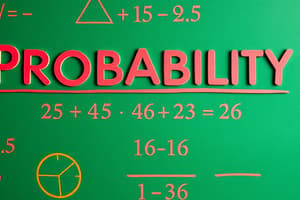Podcast
Questions and Answers
Explain why knowing whether a sequence converges is useful in determining if an infinite series converges.
Explain why knowing whether a sequence converges is useful in determining if an infinite series converges.
If the sequence of terms in an infinite series does not converge to zero, the series diverges, by the Divergence Test.
Describe the key difference between finding the limit of a sequence and finding the sum of a series.
Describe the key difference between finding the limit of a sequence and finding the sum of a series.
A sequence involves finding the value the terms approach, while a series involves adding all the terms and finding the value of the sum.
Why is the comparison test useful for determining the convergence or divergence of improper integrals?
Why is the comparison test useful for determining the convergence or divergence of improper integrals?
The comparison test helps because if an integral is bounded above or below by a convergent or divergent integral, respectively, its convergence can be determined.
Explain how the choice of the axis of revolution affects the integral setup for calculating the surface area of a solid of revolution.
Explain how the choice of the axis of revolution affects the integral setup for calculating the surface area of a solid of revolution.
Describe a scenario where integration by parts becomes particularly useful when evaluating definite integrals.
Describe a scenario where integration by parts becomes particularly useful when evaluating definite integrals.
Explain how the absolute value of (r) affects the convergence of a geometric series (\sum ar^n).
Explain how the absolute value of (r) affects the convergence of a geometric series (\sum ar^n).
Explain how the choice between using the disk/washer method versus the shell method can simplify the calculation of the volume of a solid of revolution.
Explain how the choice between using the disk/washer method versus the shell method can simplify the calculation of the volume of a solid of revolution.
How does the behavior of a function's derivative, (f'(x)), influence the arc length calculation?
How does the behavior of a function's derivative, (f'(x)), influence the arc length calculation?
When determining the convergence of an alternating series, explain why it is important to check if the absolute value of the terms is decreasing.
When determining the convergence of an alternating series, explain why it is important to check if the absolute value of the terms is decreasing.
Explain how L'Hôpital's Rule helps in evaluating limits involving sequences. Give an example.
Explain how L'Hôpital's Rule helps in evaluating limits involving sequences. Give an example.
Flashcards
Arc Length Formula
Arc Length Formula
The length of a curve y = f(x) from x = a to x = b is given by the integral of the square root of 1 plus the square of the derivative of f(x), integrated from a to b.
Surface Area of Revolution
Surface Area of Revolution
The surface area (S) obtained by rotating the curve y = f(x) about the x-axis from x = a to x = b. It involves integrating 2π * f(x) * sqrt(1 + (f'(x))^2) from a to b.
arcsin Integral
arcsin Integral
∫ dx / √(a² - x²) = sin⁻¹(x/a) + C
arctan Integral
arctan Integral
Signup and view all the flashcards
arcsec Integral
arcsec Integral
Signup and view all the flashcards
Complex Integral
Complex Integral
Signup and view all the flashcards
Study Notes
- The material is for UCLA Math 31B, Fall 2024, Midterm 2.
- The exam is on Monday, November 18.
- Instructor: David Beers
Exam Instructions and Rules
- Points are deducted if work is not shown, unless the question states otherwise.
- Answers must be written directly on the test, either on the front or back of the page where the question is written.
- Calculators, notebooks, textbooks, headphones, and cheat sheets are prohibited.
- Phones must be turned off and stored away during the exam.
- Talking or writing is not allowed on the exam after time is up.
- Violations of these rules result in a deduction of at least 25 points.
Derivative Formulas
- d/dx sin⁻¹x = 1/√(1 - x²)
- d/dx cos⁻¹x = -1/√(1 - x²)
- d/dx tan⁻¹x = 1/(x² + 1)
Integral Formulas
- ∫ dx/√(1 - x²) = sin⁻¹x + C
- ∫ -dx/√(1 - x²) = cos⁻¹x + C
- ∫ dx/(x² + 1) = tan⁻¹x + C
Arc Length
- The arc length is given by: s = ∫√(1 + (f'(x))²) dx from a to b.
Surface Area
- The surface area is given by: S = 2π ∫ f(x)√(1 + (f'(x))²) dx from a to b.
Convergence Determination
- Determine the convergence of integrals, sequences, and series; no work required; each worth 5 points
- ∫1/x dx from 1 to ∞
- ∫1/x^(9/10) dx from 0 to 1
- {(-1.5)^n}_(n=1 to ∞)
- ∑ (-1)^n from n=0 to ∞
- ∑ (1/n)^n from n=1 to ∞
Series Convergence and Value
- Determine convergence/divergence of sequence/series and compute its convergence value, show work
- Sequence {(-n/ln(n))^n} from n=2 to ∞ (12 points)
- Series ∑ 2(2/3)^n from n=3 to ∞ (13 points)
Computations Required
- Compute ∫ 1/sqrt((x-3)(x-2)) dx (12 points)
- Given f(x) = x³, compute surface area of the revolution around the x-axis on [0, 1] (13 points)
Improper Integrals
- Determine divergence/convergence of improper integrals; no computation needed, show work
- ∫ e^(-x) / (e^(-x) + x) dx from 0 to 1 (12 points)
- ∫ 1 / sqrt(x³ + x⁴) dx from 0 to 1 (13 points)
Studying That Suits You
Use AI to generate personalized quizzes and flashcards to suit your learning preferences.
Related Documents
Description
This material covers information for the UCLA Math 31B Midterm 2 exam in Fall 2024, instructed by David Beers. It includes exam instructions, derivative and integral formulas, and formulas for arc length and surface area. The exam is scheduled for Monday, November 18.




